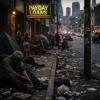
Breaking News
 US NAVY USELESS: China Activates "Land Route" to Drain Russian Silver
US NAVY USELESS: China Activates "Land Route" to Drain Russian Silver
 Lego's next-gen bricks make your creations interactive
Lego's next-gen bricks make your creations interactive
 Perhaps We Should Actually Be Focusing On Fixing America
Perhaps We Should Actually Be Focusing On Fixing America
Top Tech News
 The First Production All-Solid-State Battery Is Here, And It Promises 5-Minute Charging
The First Production All-Solid-State Battery Is Here, And It Promises 5-Minute Charging
 See inside the tech-topia cities billionaires are betting big on developing...
See inside the tech-topia cities billionaires are betting big on developing...
 Storage doesn't get much cheaper than this
Storage doesn't get much cheaper than this
 Laser weapons go mobile on US Army small vehicles
Laser weapons go mobile on US Army small vehicles
 EngineAI T800: Born to Disrupt! #EngineAI #robotics #newtechnology #newproduct
EngineAI T800: Born to Disrupt! #EngineAI #robotics #newtechnology #newproduct
 This Silicon Anode Breakthrough Could Mark A Turning Point For EV Batteries [Update]
This Silicon Anode Breakthrough Could Mark A Turning Point For EV Batteries [Update]
 Travel gadget promises to dry and iron your clothes – totally hands-free
Travel gadget promises to dry and iron your clothes – totally hands-free
 Perfect Aircrete, Kitchen Ingredients.
Perfect Aircrete, Kitchen Ingredients.
 Futuristic pixel-raising display lets you feel what's onscreen
Futuristic pixel-raising display lets you feel what's onscreen
 Cutting-Edge Facility Generates Pure Water and Hydrogen Fuel from Seawater for Mere Pennies
Cutting-Edge Facility Generates Pure Water and Hydrogen Fuel from Seawater for Mere Pennies
How Hill Helicopters Designed a Light Chopper That Looks and Feels Like a Supercar

Jason Hill has spent most of his career attempting to redefine the rotorcraft, and his futuristic HX50 chopper now looks like it may indeed establish another helicopter category. With its all-new design, from turbine to touchscreen the sleek flying machine incorporates a high-inertia three-bladed rotor system that should deliver a cruising speed of 160 mph with an 800-mile range. And while it's purported to fly well above its light-helicopter competitors in terms of avionics, styling, and interior space, what's perhaps most impressive about the five-occupant whirlybird is its intended starting price of approximately $798,000—about a third less than what a comparable rotorcraft might cost.
"The machine is designed to feel like a supercar," says Hill. "It's also geared to make everything about helicopter flying simpler than ever before." The HX50's carbon-fiber monocoque frame is a novel feature for a light-category helicopter, and the touchscreen display is proprietary to Hill. As for the roll cage, impact-absorbing seats, and crash-resistant fuel tanks and windows, those are all typically found on larger, more expensive copters.


 Not Worth a Continental
Not Worth a Continental

